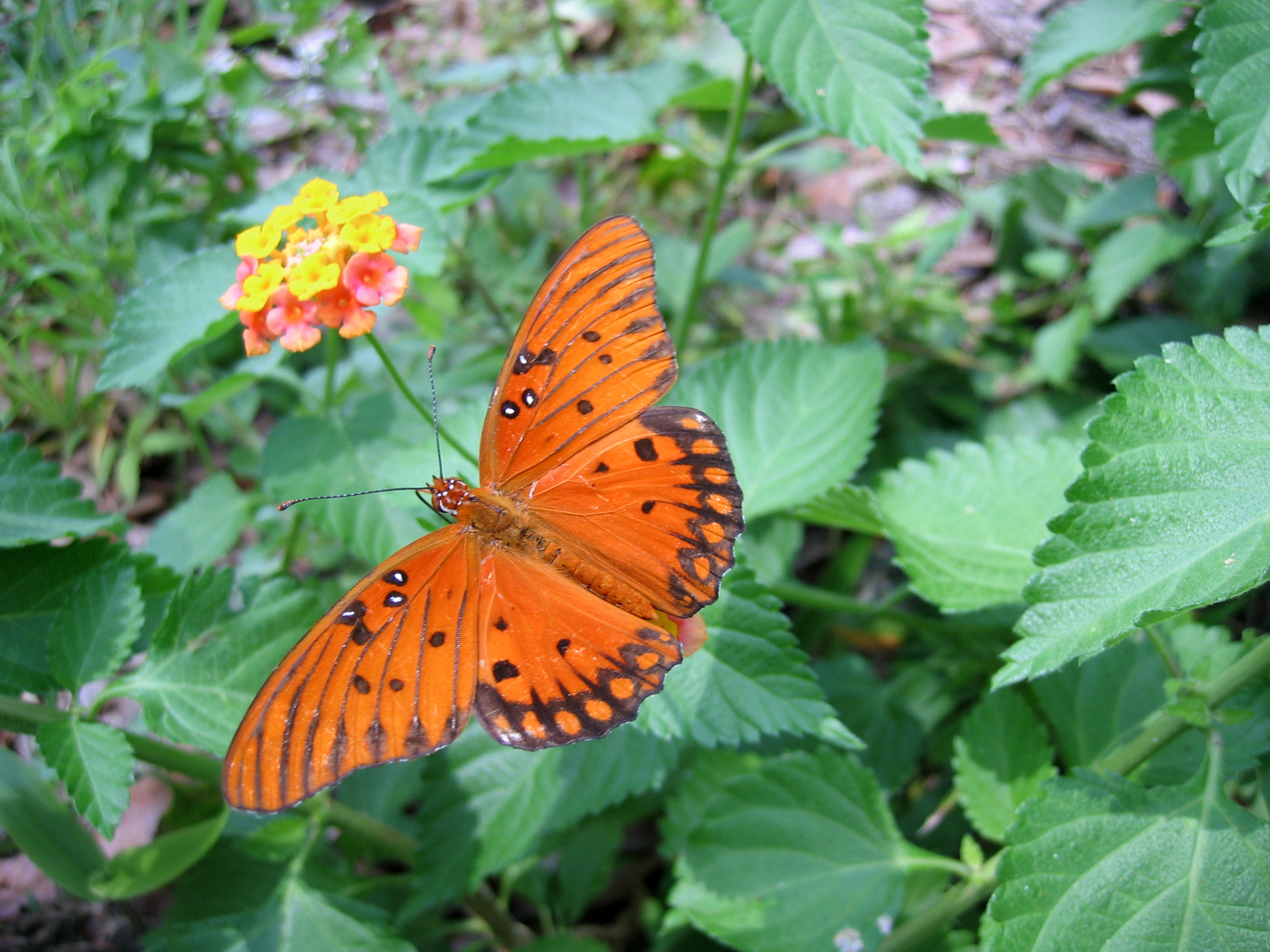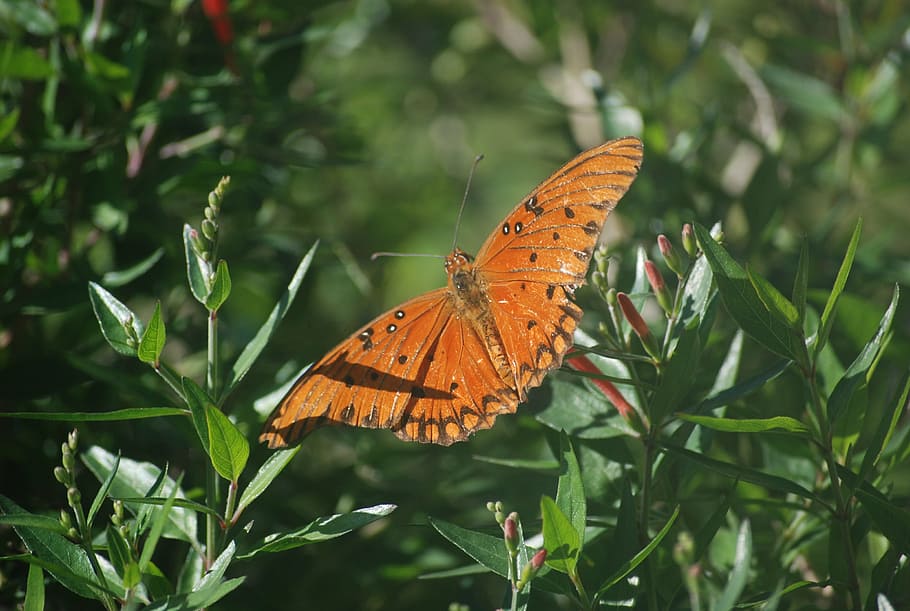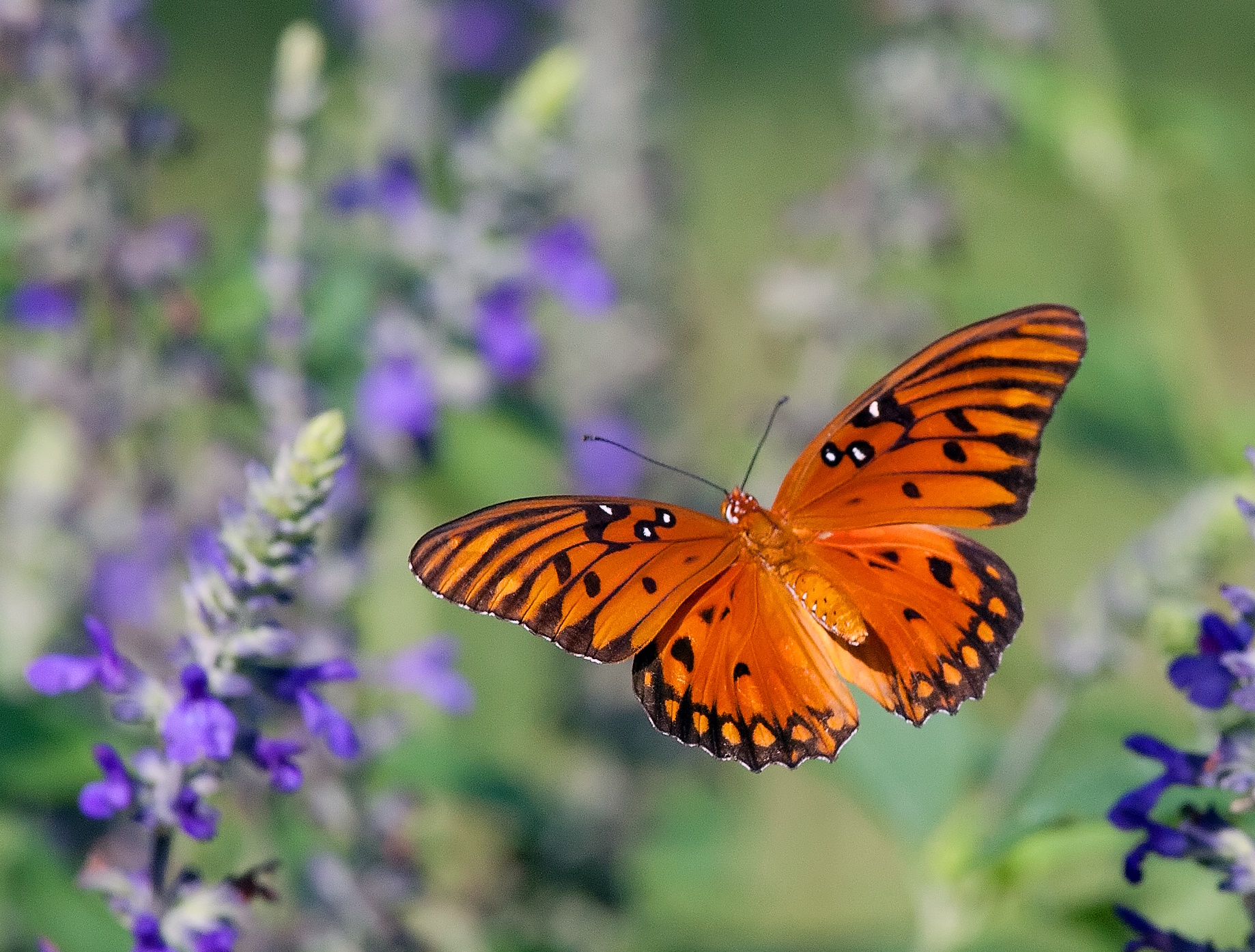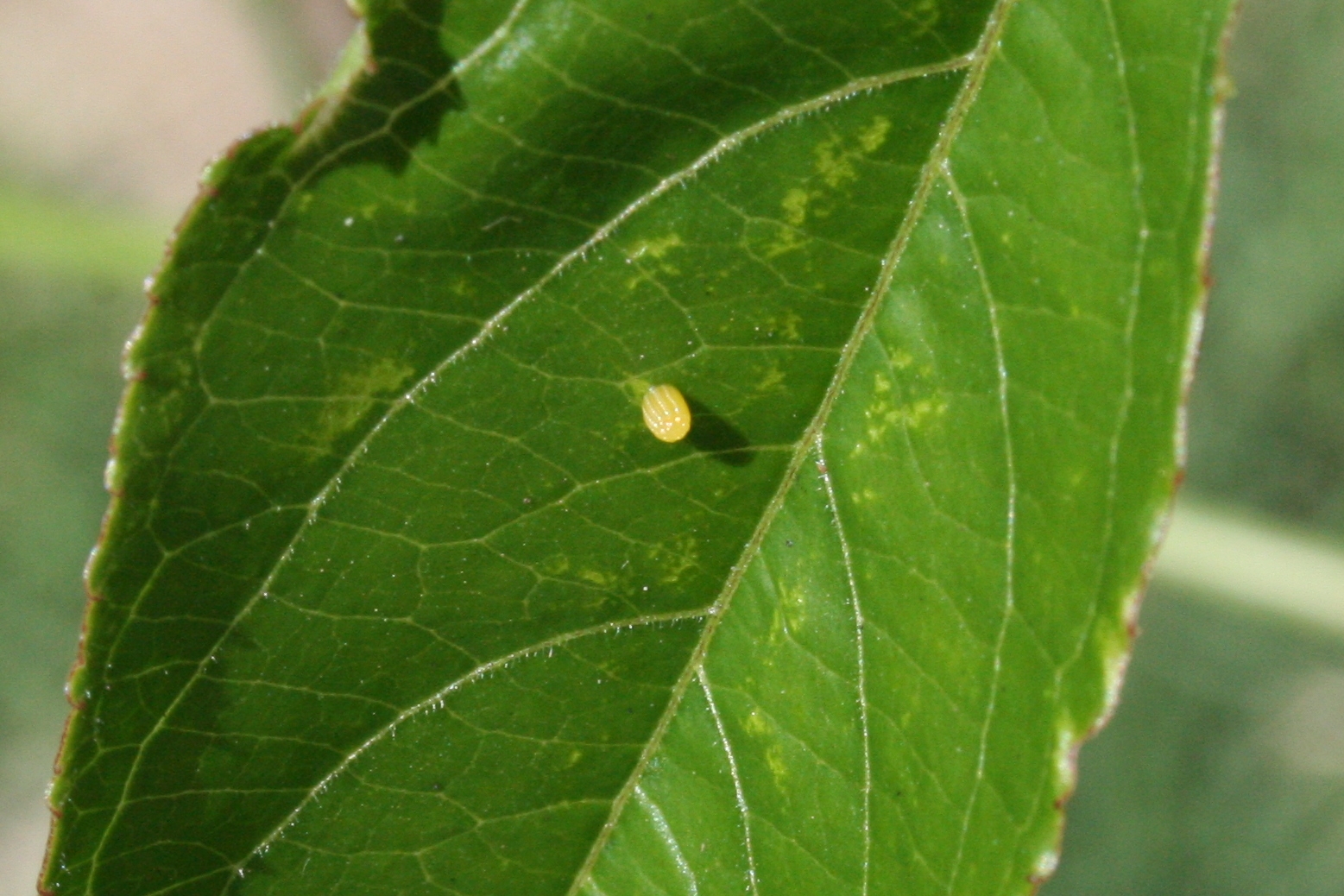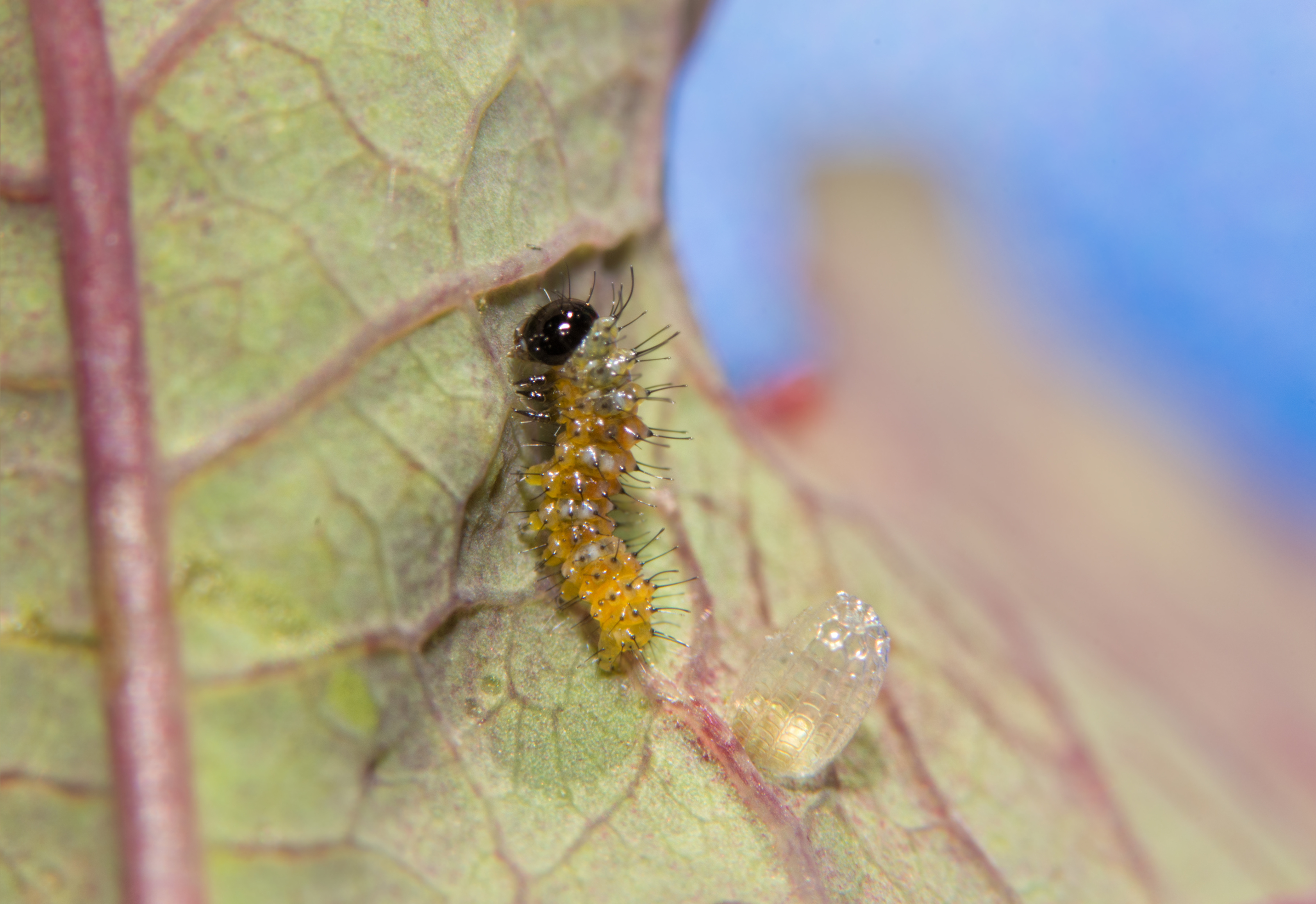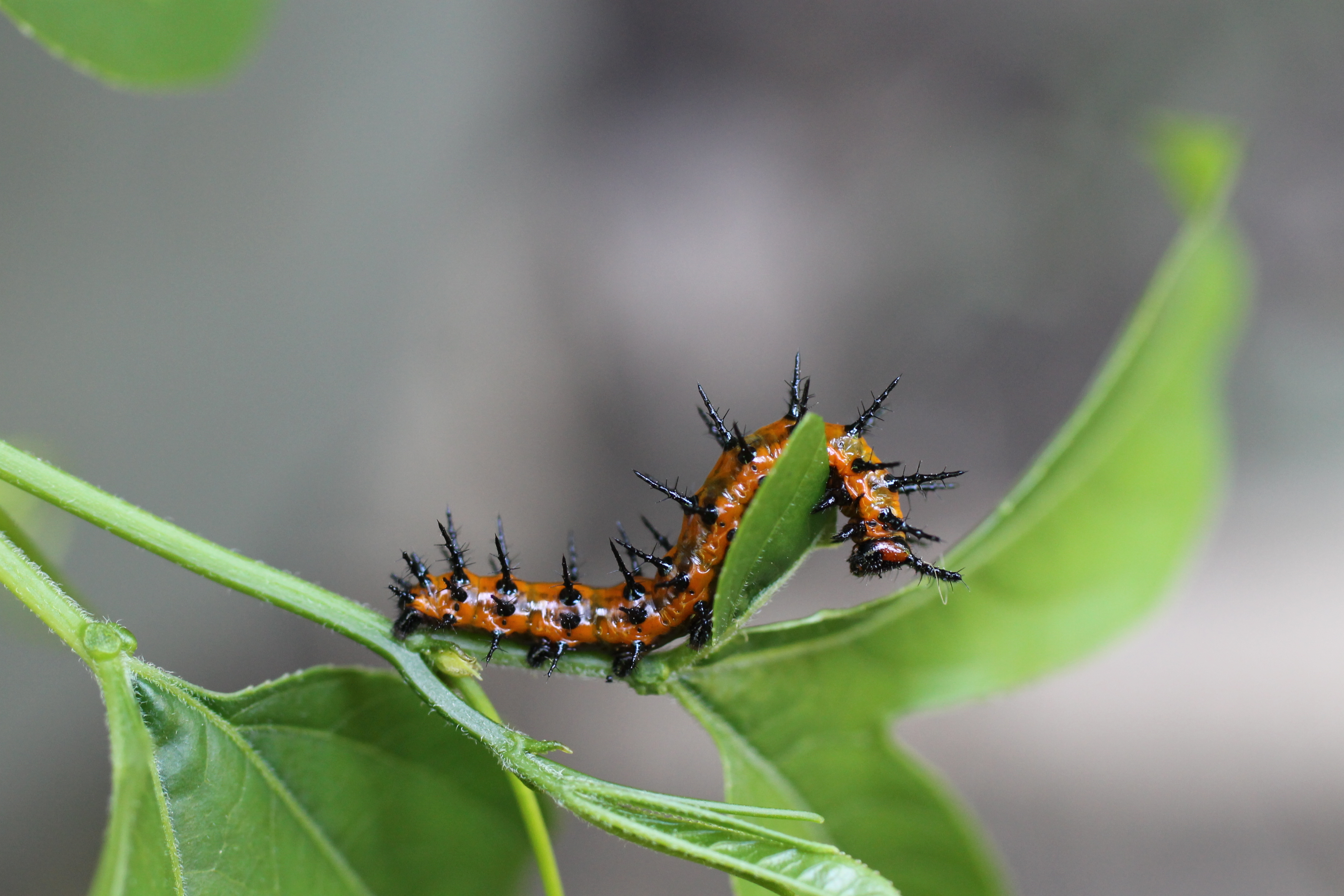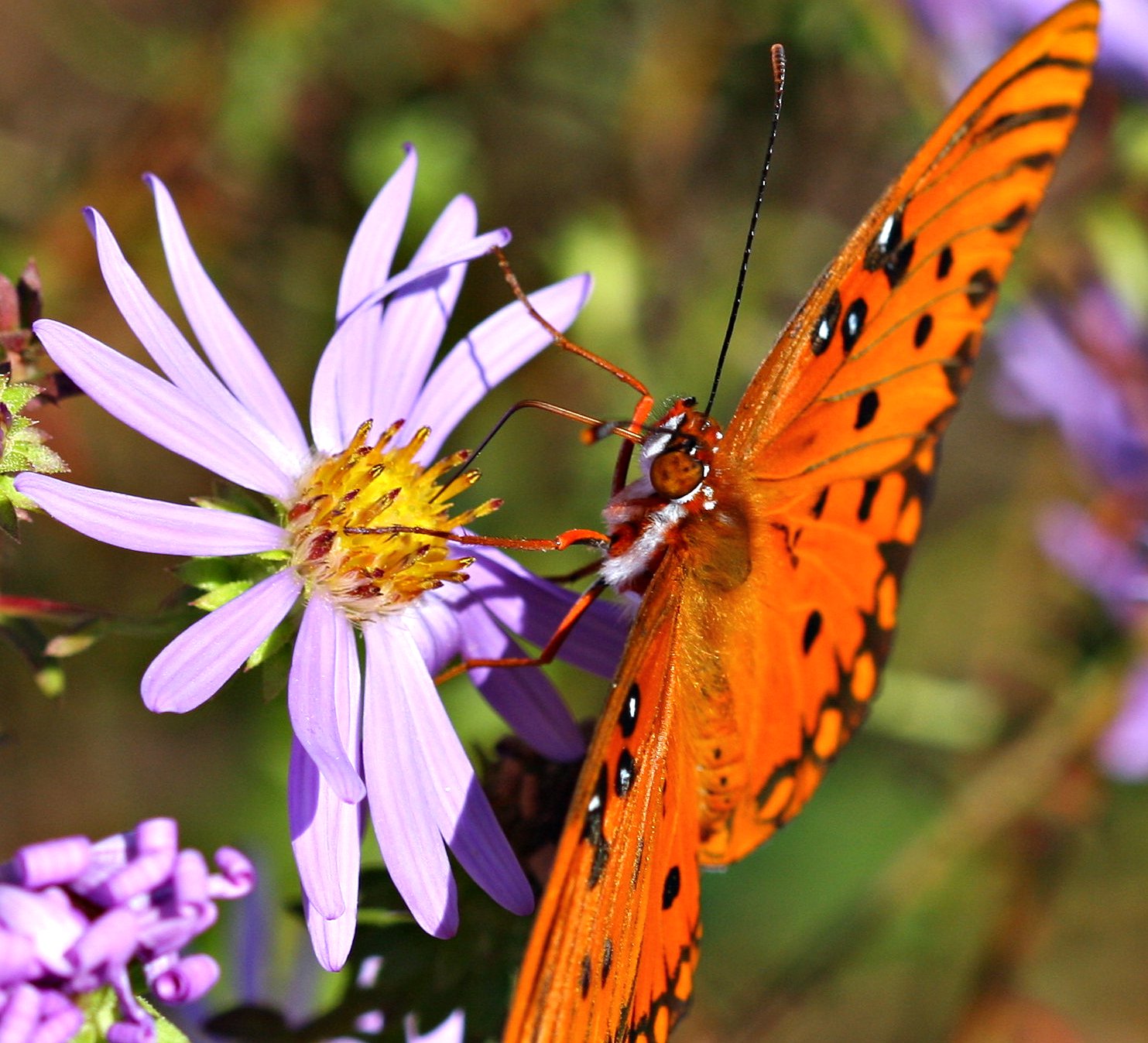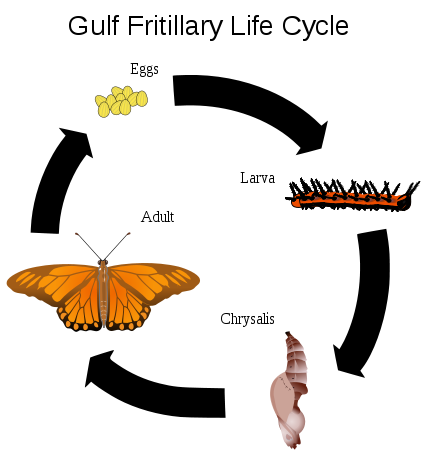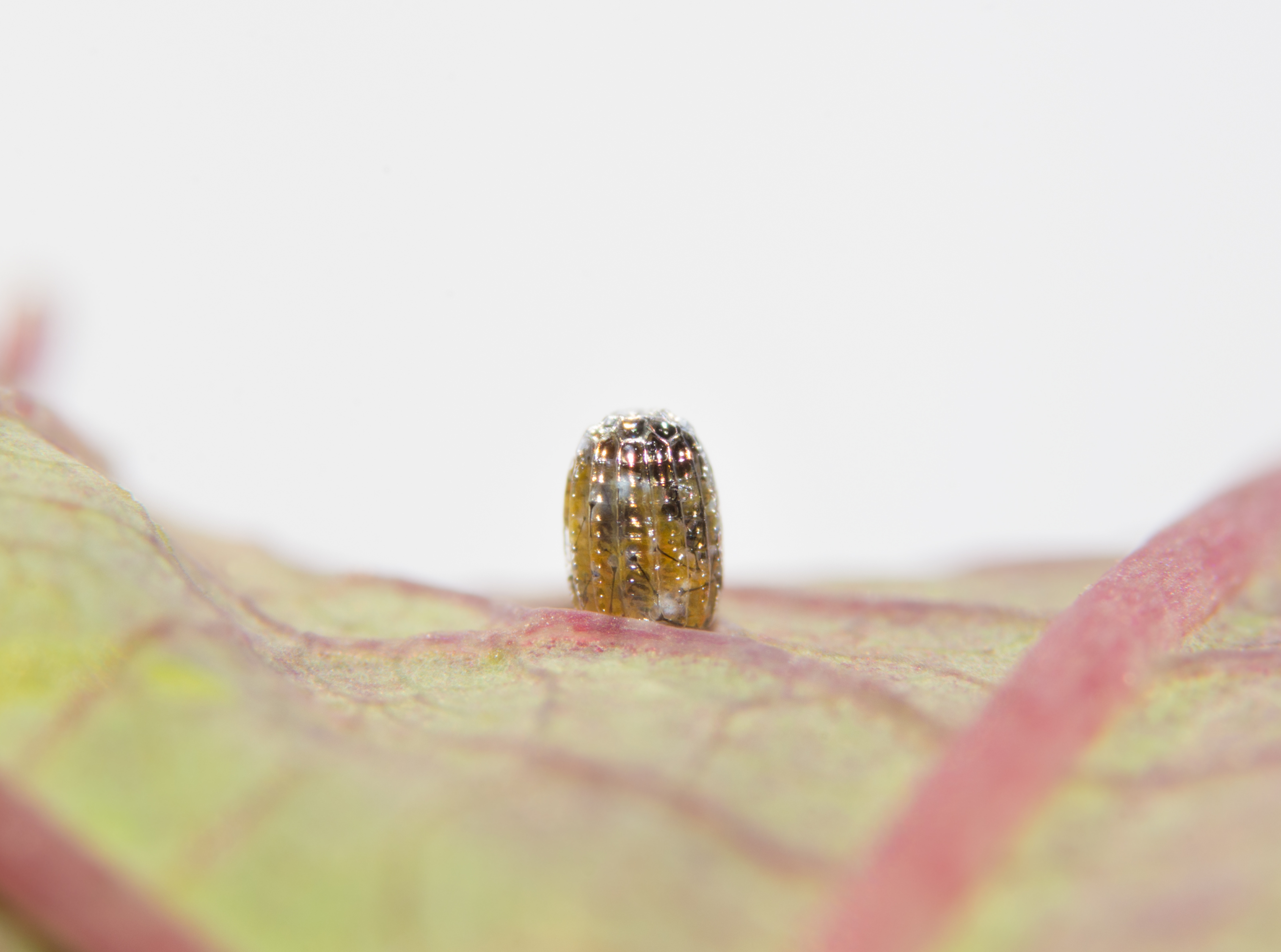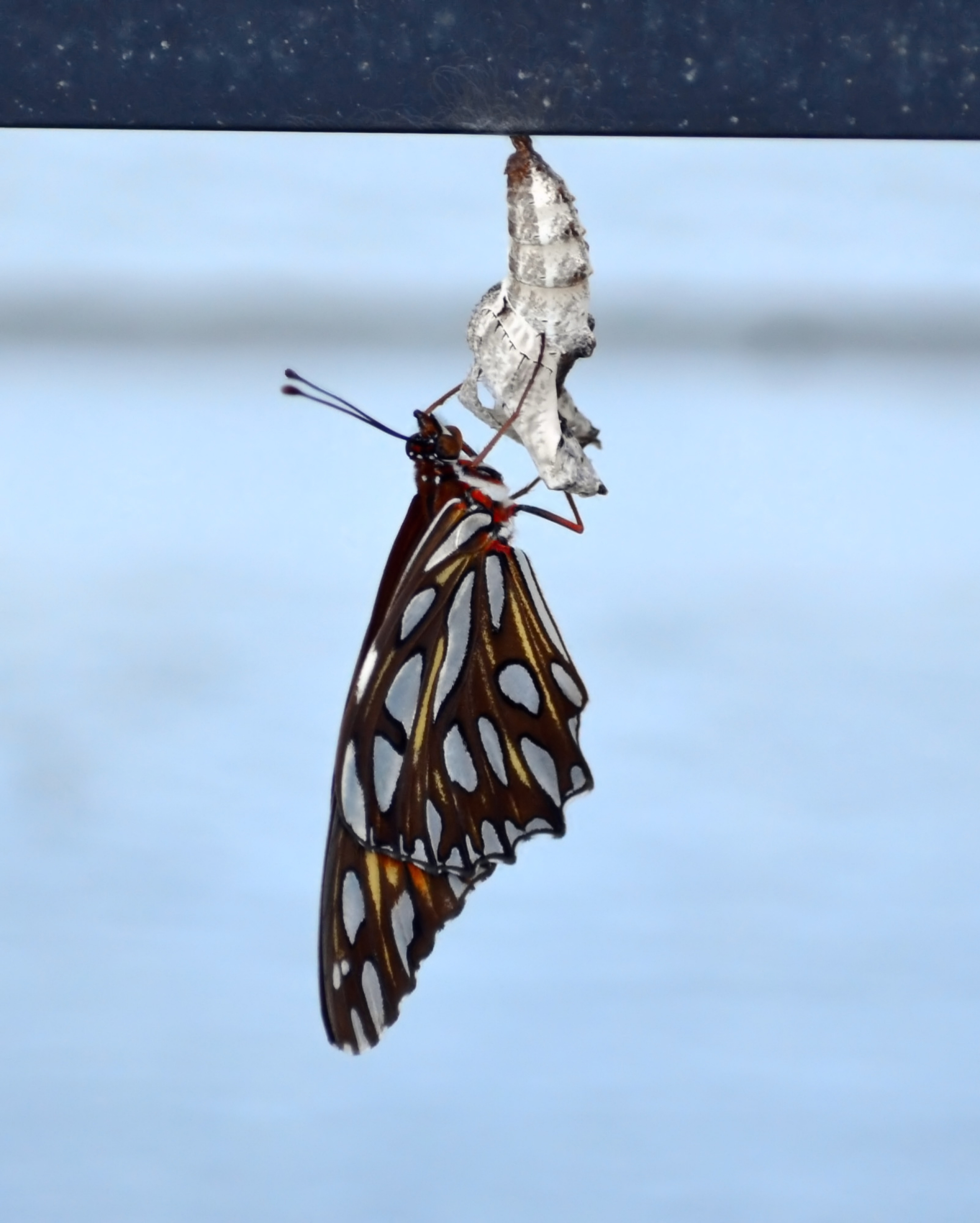Wonders of Wildlife: Gulf Fritillary
Gulf Fritillary
Other Common Names: Passion Butterfly
Scientific Name: Agraulis vanillae
Found in Alabama: Statewide
Diet: Herbivore (eats plants)
Learn more about... |
|
Gulf Fritillary Butterfly in Habitat
Paul Brennan
Click image to enlarge it |
| CLASSIFICATION |
| |
|
|
What type of animal am I?
- I am an invertebrate (an animal without a spine or backbone).
- I am cold-blooded, so I cannot control my body temperature.
- I have a stiff covering on the outside of my body called an exoskeleton.
- I breathe through small holes in my abdomen called spiracles.
- I have six legs.
- I have wings.
|
Scientists use basic traits to group animals into different taxonomic classes.
For a taxonomic classification chart comparing key traits of common backyard wildlife,
CLICK HERE! |
|
| The Gulf Fritillary is an INSECT! |
| IDENTIFICATION TIPS |
| ADULT BUTTERFLY |
|
Gulf Fritillary Butterfly
Wikimedia - Judy Gallagher
Click on image to enlarge it
|
- Wingspan ranges from 2 - 3.5 inches
- Wings are elongated, and forewings are pointed
- Body is bright orange with brown, black, and white markings
- Forewings each have three black rimmed white spots
- Wings are darker orange on the underside and have long silvery white spots
|
| |
|
| MALE |
FEMALE |
- Smaller than females
- Less deep orange than females with less prominent markings
|
- Larger than males
- Darker/deeper orange in color with more prominent dark markings
|
Gulf Fritillary Male
pxfuel
Click on image to enlarge it |
Gulf Fritillary Female
Wikimedia - Umbris
Click on image to enlarge it
|
| EGGS |
CATERPILLAR (LARVAE) |
CHRYSALIS |
- About the size of a pinhea
- Obolong and yellow with vertical ridges
Gulf Fritillary Egg
Lonnie Huffman
|
- Appear a reddish orange in color or dark brown or black with red-orange stripes running along the body
- Rows of branched, black spines
|
- Elongated and curved
- Mottled Brown in color
- Resembles a dead leaf
Gulf Fritillary Chrysalis
Dreamstime |
Young Gulf Fritillary Caterpillar
Dreamstime |
Older Gulf Fritillary Caterpillar
Dreamstime |
| Click on images to enlarge them |
| ADAPTATIONS |
| |
| PHYSICAL ADAPTATIONS |
| |
| Gulf Fritillaries taste bad to predators: |
- As the caterpillars feed on passionflower plants, they absorb the toxins (poison produced by a living organism) from the plant.
- These toxins are stored in their bodies and remain present when they emerge as adult butterflies.
- The toxins they ingest when feeding on the host plant make them taste bad to predators (animals that eat them).
- Their bright orange color acts as a warning signal to predators.
|
| |
|
| Gulf Fritillaries avoid predators using scent: |
- Adult gulf fritillary butterflies have a gland on the abdomen that releases a chemical when the butterfly is disturbed.
- The scent deters larger predators (animals that eat them) from consuming them.
|
| |
|
| Gulf Fritillaries have long straw-like mouthparts: |
- All butterflies and moths have a long straw-shaped mouthpart (similar to a tongue) called a proboscis that they use to collect nectar from flowers.
- The proboscis has two long tubes (like straws) that soak up the nectar deep inside the flower, and then the nectar travels up through the tubes for the butterfly to drink it.
- When the proboscis is not in use, it curls up tightly against the front of the head of the butterfly.
- To see how a proboscis works and to learn why scientists are studying the proboscis, watch Science Nation's 3-minute video.
|
Gulf Fritillary on Flower
Wikimedia - John Flannery
Click on image to enlarge it
|
- Gulf fritillaries and other members of the same group are known for collecting pollen in the proboscis and are able to absorb pollen through the wall of the proboscis.
|
| |
| Butterflies have compound eyes: |
- Butterfly vision is completely different than human vision.
- While humans have the ability to focus on something far away and can see fine details, a butterfly's vision appears blurry to them because they have compound eyes (many individual lenses that combine to form one image).
- Butterflies have special structures that allow them to see different types of light than humans, helping them locate flowers and communicate with each other.
- They are also able to see a more wide view around them rather than just in front of them, allowing them to detect and escape any threats.
|
| BEHAVIORAL ADAPTATIONS |
| |
| Gulf Fritillaries are diurnal: |
- They are active during the day (diurnal).
|
| |
| Gulf Fritillaries communicate with one another: |
- Male gulf fritillaries do a "wing clap display" in order to attract females.
- The male perches and flaps its wings open and shut as a display for the female.
- The males also release pheromones (chemicals) that the female should recognize.
|
| |
| Gulf Fritillaries are migratory: |
- Gulf fritillaries are native to the southern United States, Mexico, Central America, and South America.
- In the spring, gulf fritillary butterflies migrate (move as a group from one location to another) north toward central United States to breed.
- They cannot tolerate colder weather, so they migrate back down to the southern portions of their range in the late summer and fall where the last generation will overwinter.
|
| |
| LIFE CYCLE |
| |
Stages of a Gulf Fritillary's Life Cycle
Wikimedia - Bugboy52.40
Click on image to enlarge it |
Metamorphosis is the process of physical change that some animals go through as they transform from a larvae into an adult.
To view the US Fish and Wildlife Service video of a monarch caterpillar changing into its chrysalis form,
CLICK HERE! |
|
| Four Life Cycle Stages of the Gulf Fritillary |
| |
|
|
1. Egg: |
- Females lay a single hard-shelled egg at a time on leaves of their host plant (the passionflower vine).
- They have several broods (groups of young) per season. A tiny caterpillar (larvae)
- The caterpillar hatches from its egg 3-5 days later.
|
Gulf Fritillary Egg
Dreamstime
Click on image to enlarge it
|
| |
|
2. Larvae: |
- The baby caterpillar spends 11-16 days eating its host plant and growing.
- When it becomes too large for its skin, it molts (sheds its skin).
- The intervals between molts are called instars.
|
| |
|
|
3. Pupa: |
- The caterpillar pupates in a head-up position.
- Its skin splits, and the curved, brown chrysalis (butterfly pupa enclosed in a protective covering) forms. Inside the chrysalis, the caterpillar undergoes metamorphosis in about 11-21 days.
|
Gulf Fritillary Butterfly Recently Emerged
Dreamstime
Click on image to enlarge it
|
4: Adult: |
- The adult butterfly emerges from the chrysalis (butterfly pupa enclosed in a protective covering), and then waits to allow its wings to inflate and dry before it flies away.
|
LifeSpan: |
- The average life span of the adult butterfly is 14 - 27 days.
|
| |
|
|
NATURAL
Habitat Needs |
ADULTS |
YOUNG |
| Food |
- Adult butterflies feed on the nectar of maypops and other passion-vine species.
- They will also feed on nectar of other nectar producing species like Lantana, Zinnia, Aster, Verbena, Thistle.
|
- The caterpillars feed exclusively pasionflower vine, their host plant.
|
| Water |
- Hydration is obtained by using their long, straw-like mouthparts while collecting nectar of native flowering plants.
- They will also drink from puddles or mud to get salt and other minerals.
|
- Hydration is obtained while feeding on the leaves and stems of host plant.
|
| Shelter |
- They prefer to live in open, sunny habitats including roadsides, fields, open woodlands, pastures, and yards.
|
- Eggs are deposited on the leaves and stems of the host plant (passionflower vine).
- Caterpillars remain on plant until they are ready to undergo metamorphosis (physical change from larva to adult), at which point the chrysalis (butterfly pupa enclosed in a protective covering) hangs under a well-covered area.
|
| Places to Raise Young |
- Females lay eggs on leaves and stems of host plant.
- Adults do not raise the young, but the plant provides a food source for the caterpillars as soon as they hatch.
|
|
BACKYARD
Habitat Needs |
ADULTS |
YOUNG |
| Food |
- Plant native nectar producing plants such as red clover, lantana, phlox, and thistle.
|
- Plant passionflower vine.
|
| Water |
- Plant nectar-producing plants.
- Add puddling stations or a small, shallow pond.
|
| Shelter |
- Plant nectar-producing plants.
|
| Places to Raise Young |
- Plant passionflower vine.
|
|
| ECOLOGICAL ROLE |
| |
|
| Animals play an important ecological role in the health of habitats and ecosystems. |
| |
|
Food Source: |
- Caterpillar and adult gulf fritillary butterflies contain a toxin (poison produced by living things) that makes taste bad to birds.
- Caterpillars are eaten by invertebrates (animals without a spine or backbone) like wasps, lady beetles, and spiders.
|
| |
|
Pollinator: |
- Adult gulf fritillary butterflies serve as pollinators (animals that move pollen, the powdery yellow substance found in flowers, from one plant to another) for native wildflowers by transferring pollen among flowers while they are foraging for nectar.
|
INFORMATION SOURCES FOR THIS SPECIES
.






 Wildlife Tag
Wildlife Tag
